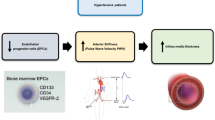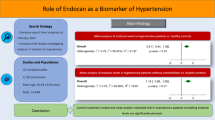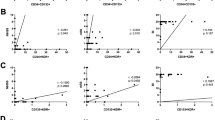Abstract
Circulating endothelial progenitor cells (EPCs) play a key role in the maintenance of endothelial homoeostasis and promote vascular repair. They may also be of predictive value for cardiovascular events. Reduced EPC number and functional activity have been associated with several cardiovascular risk factors, but their relationship with hypertension remains unclear. The objective of this study was to investigate if number and function of circulating EPCs are reduced in patients with refractory hypertension (RHT). Circulating EPCs (CD34+ CD133+/CD45+) were isolated from peripheral blood by flow cytometry in 39 RHT and 30 normotensive controls. EPC number was also determined in vitro after 7 days in culture. After age adjustment, EPC concentration was significantly reduced in RHT as compared with controls (mean (95% CI), 33.8 (18.1–49.6) vs 69.1 (50.7–87.5) EPCs per 105 peripheral mononuclear cells (MNCs), respectively; P=0.014). After in vitro culture, EPCs were also reduced in patients as compared with controls (mean (95% CI), 142.3 (49.5–235.0) vs 611.0 (480.2–741.8) EPCs per field, respectively, P<0.001). In multiple linear regression analysis, circulating EPCs were significantly reduced by 56.3% in RHT as compared with control (P=0.006), independently of all other known risk factors. Moreover, RHT had a high independent predictive value for lower EPC proliferation. The number of EPCs per field was reduced by 76.7% in RHT with respect to controls (P<0.001). In summary, the number of circulating EPCs after culture is reduced in patients with RHT, which may be related to the increased rate of endothelial dysfunction, atherosclerotic disease and cardiovascular events observed in this population.
This is a preview of subscription content, access via your institution
Access options
Subscribe to this journal
Receive 12 digital issues and online access to articles
$119.00 per year
only $9.92 per issue
Buy this article
- Purchase on Springer Link
- Instant access to full article PDF
Prices may be subject to local taxes which are calculated during checkout


Similar content being viewed by others
References
Kaplan NM . Resistant hypertension. J Hypertens 2005; 23: 1441–1444.
Cuspidi C, Macca G, Sampieri L, Michev I, Salerno M, Fusi V et al. High prevalence of cardiac and extracardiac target organ damage in refractory hypertension. J Hypertens 2001; 19: 2063–2070.
Perticone F, Ceravolo R, Pujia A, Ventura G, Iacopino S, Scozzafava A et al. Prognostic significance of endothelial dysfunction in hypertensive patients. Circulation 2001; 104: 191–196.
Juonala M, Viikari JS, Ronnemaa T, Helenius H, Taittonen L, Raitakari OT . Elevated blood pressure in adolescent boys predicts endothelial dysfunction: the cardiovascular risk in young Finns study. Hypertension 2006; 48: 424–430.
Urbich C, Dimmeler S . Endothelial progenitor cells: characterization and role in vascular biology. Circ Res 2004; 95: 343–353.
Asahara T, Murohara T, Sullivan A, Silver M, van der Zee R, Li T et al. Isolation of putative progenitor endothelial cells for angiogenesis. Science 1997; 275: 964–967.
Liew A, Barry F, O'Brien T . Endothelial progenitor cells: diagnostic and therapeutic considerations. BioEssays 2006; 28: 261–270.
Rafii S, Lyden D . Therapeutic stem and progenitor cell transplantation for organ vascularization and regeneration. Nat Med 2003; 9: 702–712.
Khakoo AY, Finkel T . Endothelial progenitor cells. Annu Rev Med 2005; 56: 79–101.
Hristov M, Weber C . Endothelial progenitor cells: characterization, pathophysiology, and possible clinical relevance. J Cell Mol Med 2004; 8: 498–508.
Schmidt-Lucke C, Rössig L, Fichtlscherer S, Vasa M, Britten M, Kamper U et al. Reduced number of circulating endothelial progenitor cells predicts future cardiovascular events. Circulation 2005; 111: 2981–2987.
Werner N, Kosiol S, Schiegl T, Ahlers P, Walenta K, Link A et al. Circulating endothelial progenitor cells and cardiovascular outcomes. N Engl J Med 2005; 353: 999–1007.
Chironi G, Walch L, Pernollet MG, Gariepy J, Levenson J, Rendu F et al. Decreased number of circulating CD34(+)KDR(+) cells in asymptomatic subjects with preclinical atherosclerosis. Atherosclerosis 2007; 191: 115–120.
Vasa M, Fichtlscherer S, Aicher A, Adler K, Urbich C, Martin H et al. Number and migratory activity of circulating endothelial progenitor cells inversely correlate with risk factors for coronary artery disease. Circ Res 2001; 89: e1–e7.
Scheubel RJ, Zorn H, Silber RE, Kuss O, Morawietz H, Holtz J et al. Age-dependent depression in circulating endothelial progenitor cells in patients undergoing coronary artery bypass grafting. J Am Coll Cardiol 2003; 42: 2073–2080.
Loomans CJM, de Koning EJP, Staal FJT, Rookmaaker MB, Verseyden C, de Boer HC et al. Endothelial progenitor cell dysfunction. A novel concept in the pathogenesis of vascular complications of type 1 diabetes. Diabetes 2004; 53: 195–199.
Tepper OM, Gagne PJ, Galiano RD, Capla JM, Kalka C, Jacobowitz GR et al. Human endothelial progenitor cells from type II diabetics exhibit impaired proliferation, adhesion, and incorporation into vascular structures. Circulation 2002; 106: 2781–2786.
Hill JM, Zalos G, Halcox JPJ, Schenke WH, Waclawiw MA, Quyyumi AA et al. Circulating endothelial progenitor cells, vascular function, and cardiovascular risk. N Engl J Med 2003; 348: 593–600.
Zhu J, Wang X, Chen J, Sun J, Zhang F . Reduced number and activity of circulating endothelial progenitor cells from patients with hyperhomocysteinemia. Arch Med Res 2006; 37: 484–489.
Zhu JH, Chen JZ, Wang XX, Xie XD, Sun J, Zhang FR . Homocysteine accelerates senescence and reduces proliferation of endothelial progenitor cells. J Mol Cell Cardiol 2006; 40: 648–652.
Boos CJ, Goon PKY, Lip GYH . Endothelial progenitor cells in the vascular pathophysiology of hypertension: arterial stiffness, ageing and more. J Hum Hypertens 2006; 20: 475–477.
Delva P, Degan M, Vallerio P, Arosio E, Minuz P, Amen G et al. Endothelial progenitor cells in patients with essential hypertension. J Hypertens 2007; 25: 127–132.
Chobanian AV, Bakris GL, Black HR, Cushman WC, Green LA, Izzo JL et al. JNC-VII: The seventh report of the Joint National Committee on Prevention, Detection, Evaluation, and Treatment of High Blood Pressure. The JNC 7 report. JAMA 2003; 289: 2560–2575.
Mancia G, De Backer G, Dominiczak A, Cifkova R, Fagard R, Germano G et al. 2007 guidelines for the management of arterial hypertension: the Task Force for the Management of Arterial Hypertension of the European Society of Hypertension (ESH) and of the European Society of Cardiology (ESC). J Hypertens 2007; 25: 1105–1187.
Soler MJ, Martínez-Estrada OM, Puig-Marí JM, Marco-Feliu D, Oliveras A, Vila J et al. Circulating endothelial progenitor cells alter kidney transplantation. Am J Transplant 2005; 5: 2154–2159.
Peichev M, Naiyer AJ, Pereira D, Zhu Z, Lane WJ, Williams M et al. Expression of VEGFR-2 and AC133 by circulating human CD34+ cells identifies a population of functional endothelial precursors. Blood 2000; 95: 952–958.
Hristov M, Erl W, Weber PC . Endothelial progenitor cells. Mobilization, differentiation, and homing. Arterioscler Thromb Vasc Biol 2003; 23: 1185–1189.
Werner N, Nickenig G . Influence of cardiovascular risk factors on endothelial progenitor cells. Limitations for therapy? Arterioscler Thromb Vasc Biol 2006; 26: 257–266.
Levey AS, Bosch JP, Breyer J, Green T, Rogers N, Roth D . A more accurate method to estimate glomerular filtration rate from serum creatinine: a new prediction equation. Ann Intern Med 1999; 130: 461–470.
van Zonneveld AJ, Rabelink TJ . Endothelial progenitor cells: biology and therapeutic potential in hypertension. Curr Opin Nephrol Hypertens 2006; 15: 167–172.
Fogo AB . New capillary growth: a contributor to regression of sclerosis? Curr Opin Nephrol Hypertens 2005; 14: 201–203.
Khan SS, Solomon MA, McCoy Jr JP . Detection of circulating endothelial cells and endothelial progenitor cells by flow cytometry. Cytometry B Clin Cytom 2005; 64: 1–8.
Taguchi A, Matsuyama T, Moriwaki H, Hayashi T, Hayashida K, Nagatsuka K et al. Circulating CD34-positive cells provide an index of cerebrovascular function. Circulation 2004; 109: 2972–2975.
Michaud SE, Dussault S, Haddad P, Groleau J, Rivard A . Circulating endothelial progenitor cells from healthy smokers exhibit impaired functional activities. Atherosclerosis 2006; 187: 423–432.
Kondo T, Hayashi M, Takeshita K, Numaguchi Y, Kobayashi K, Iino S et al. Smoking cessation rapidly increases circulating progenitor cells in peripheral blood in chronic smokers. Arterioscler Thromb Vasc Biol 2004; 24: 1442–1447.
Laufs U, Werner N, Link A, Endres M, Wassmann S, Jürgens K et al. Physical training increases endothelial progenitor cells, inhibits neointima formation, and enhances angiogenesis. Circulation 2004; 109: 220–226.
de Groot K, Bahlmann FH, Sowa J, Koenig J, Menne J, Haller H et al. Uremia causes endothelial progenitor cell deficiency. Kidney Int 2004; 66: 641–646.
Choi JH, Kim KL, Huh W, Kim B, Byun J, Suh W et al. Decreased number and impaired angiogenic function of endothelial progenitor cells in patients with chronic renal failure. Arterioscler Thromb Vasc Biol 2004; 24: 1–9.
Dimmeler S, Aicher A, Vasa M, Mildner-Rihm C, Adler K, Tiemann M et al. HMG-CoA reductase inhibitors (statins) increase endothelial progenitor cells via the PI3-kinase/Akt pathway. J Clin Invest 2001; 108: 391–397.
Bahlmann FH, de Groot K, Mueller O, Hertel B, Haller H, Fliser D . Stimulation of endothelial progenitor cells. A new putative therapeutic effect of angiotensin II receptor antagonists. Hypertension 2005; 45: 526–529.
Imanishi T, Hano T, Nishio I . Angiotensin II accelerates endothelial progenitor cell senescence through induction of oxidative stress. J Hypertens 2005; 23: 97–104.
Min TQ, Zhu CJ, Xiang WX, Hui ZJ, Peng SY . Improvement in endothelial progenitor cells from peripheral blood by ramipril therapy in patients with stable coronary artery disease. Cardiovasc Drugs Ther 2004; 18: 203–209.
George J, Shmilovich H, Deutsch V, Miller H, Keren G, Roth A . Comparative analysis of methods for assessment of circulating endothelial progenitor cells. Tissue Eng 2006; 12: 331–335.
Acknowledgements
We thank Sergi Mojal for assistance in data management and analysis. We also thank Dr J Wysocki for reviewing the manuscript. We appreciate the collaboration of Núria Pujolar and the nursery staff of the Nephrology Department of the Hospital del Mar, and the secretarial support of Mercè Borderia.
Author information
Authors and Affiliations
Corresponding author
Additional information
Conflict of interest
None.
Sources of funding
None.
Rights and permissions
About this article
Cite this article
Oliveras, A., Soler, M., Martínez-Estrada, O. et al. Endothelial progenitor cells are reduced in refractory hypertension. J Hum Hypertens 22, 183–190 (2008). https://doi.org/10.1038/sj.jhh.1002304
Received:
Revised:
Accepted:
Published:
Issue Date:
DOI: https://doi.org/10.1038/sj.jhh.1002304
Keywords
This article is cited by
-
Circulating endothelial and angiogenic cells predict hippocampal volume as a function of HIV status
Journal of NeuroVirology (2023)
-
Endothelial progenitor cells as the target for cardiovascular disease prediction, personalized prevention, and treatments: progressing beyond the state-of-the-art
EPMA Journal (2020)
-
Control of stress signaling in stem cells: crossroads of stem cells and cancer
Tumor Biology (2016)
-
Quantitative and functional characteristics of endothelial progenitor cells in newly diagnosed hypertensive patients
Journal of Human Hypertension (2015)
-
Endothelial progenitor cells in cardiovascular diseases: from biomarker to therapeutic agent
Regenerative Medicine Research (2013)



